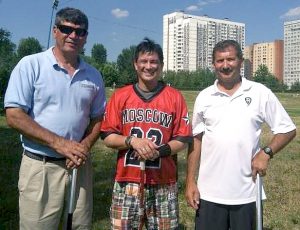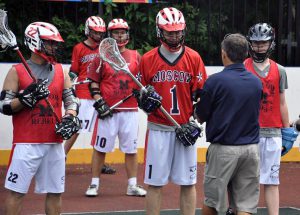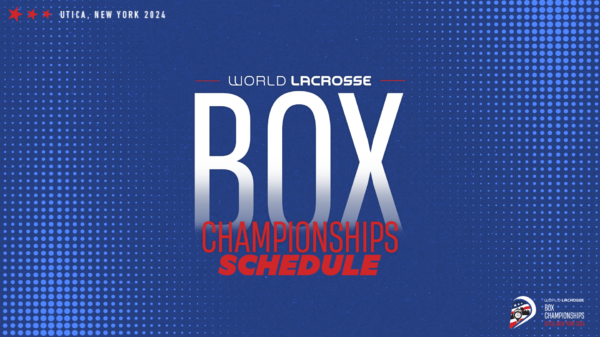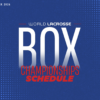(MOSCOW, RUSSIA) As representatives of the FIL, we would like to take this opportunity to thank all those that made this trip possible. Special thanks to Director of Development, Tom Hayes and Director of European Development, Bob DeMarco.
As always, their enthusiasm, professionalism, and experience provide the foundation for the development of lacrosse worldwide.

FIL European Coordinator Bob DeMarco (left) and FIL Clinician Rick Mercurio (right) with Russian Lacrosse Representative David Diamonon. © FIL
Through their efforts, Russian Lacrosse has gained much knowledge, structure, and focus. The clinics achieved the objectives of enhancement of individual and team skills with emphasis being placed on the need of those players and coaches in attendance to share what they have learned, so that lacrosse will continue to grow and improve in their country.
I would like to thank David Diamonon (representative of Russian Lacrosse) for organizing the developmental clinic. He was our gracious host, guide, organizer, and liaison.
I would also like to thank Lacrosse Unlimited and Team Sales Rep., Pat Perritt for their generous donation. They provided several dyed stick heads, shirts and gifts to be awarded to the Russian players in attendance. It was a big hit and all the recipients were very honored and gracious to have received them.
Overview
Russian Lacrosse, in its short time, is progressing well. They presently have two coed clubs, the St. Petersburg White Knights and the Moscow Rebels.

Russian women lacrosse players currently play on men’s teams. © FIL
To understand its progress, one needs to know a little about its culture, logistics, economics, government, etc. The Soviet Union (or as most of us knew it-The USSR), fell completely on Dec. 26th, 1991. Since then it has been evolving and going through a metamorphic era. While we are not experts on any of these matters, we observed certain key factors or concerns that are related to their unique situation: Almost all of Russia’s population lives within a few major cities. The concept of suburbia, single family houses, small communities, etc. does not exist. Everyone lives in apartments; most players do not own cars and must use public transportation. Moscow is very crowded and space, especially “field space”, is at a premium. If you want to use any of the maintained sports venues, it comes at an expense. The teams are constantly changing practice facilities and struggle to obtain any time commitment for field space. Most times they go to public parks and hope they can find some space on which to play.
Almost all of players have to take the subway system with their equipment, get off at the nearest station to these parks, and then walk a good distance to the field. Dave has a company SUV and cramps equipment, balls, cages, etc., into it and hauls it to the designated site. We gave Kudos to all that did it, for they love the game.
Summary

Rick Mercurio instructing some of the Moscow Rebels team members during clinic. © FIL
Lacrosse in Russia has a solid foundation under the leadership of David Diamonon. He has maintained a good balance of the enjoyment of the game along with the spirit of dedication and a commitment from each of the players in sharing the responsibility for the improvement and growth of the game within their country. They continue to encourage, and promote participation. We implored all the players to recruit and educate. Dave has been running advertisements in the Moscow Times and has seen good results. Of the few women that attended the clinic and participate in Russia, all of them play on the men’s club teams. We encouraged them to continue participating and to make every effort to recruit other women with the goal of eventually starting a women’s club team. It was very clear that the Russians want to improve their level of play and participation. They are looking to play in tournaments in Belgium and in the very near future host a tournament in Russia. Their main goal is to participate in the World Games in the USA in 2014. We would be very proud to see them there.
In all there were over 32 participants including five women over the two days of clinics. Five of the players traveled several hours by train from St. Petersburg to participate. One suggestion we made, was to start seeking cooperate sponsorship. Ironically, as I was discussing this with Dave, Bob went to the ATM and ran into the General Mgr. of Operations from Pepsi. The gentleman happen to play lacrosse at a high school in Howard County, Md. Bob got his contact info, passed it on to Dave and Dave has since made contact with him. Small World!!
Day-by-day Report
Prior to our departure date of July 5th, 2012
After many hours of documentation, filling out forms online and two trips into Manhattan, we were able to receive our visas to enter Russia. Bob and Zoni DeMarco were extremely diligent and helpful throughout the process. We received our visas on June 25th, only a week prior to our departure. We were a little more than concerned that we would not get them in time. Any plans for future trips to Russia must take into account the extended time needed to obtain a visa.
Thursday, July 5th
We departed at 11:00AM to JFK for a 4:10PM direct flight to Moscow.
Friday, July 6th
We arrived at Moscow International at 9:55AM. The flight took about 10hrs and Russia is 8 hours ahead of us. After clearing customs we were met by Dave’s company driver. He drove us to our accommodations. The apartment, which is owed by Transolutions CIS (Dave’s Co.) was comfortable and clean and conveniently located near the clinic sites.
After some rest we were met by David and then we went to dinner at a local Russian restaurant. We spent time getting acquainted, shared stories, and most importantly reviewed our itinerary and plans for the lacrosse clinics. Dave also shared his vision and determination to see lacrosse grow in Russia.
Saturday, July 7th
Dave picked us up at 10:00AM for the start of an 11:30AM clinic. We headed over to Krasnaya Presayna Park in Central Moscow where the American Chamber of Commerce was hosting an Independence Day Celebration in Russia. At first the concept seemed a bit odd and out of place. However, we soon realized that there are many major American companies that have vested interests in Russia.
Dave had informed us the night before that the site of the clinic was supposed to be held at the Anglo School. He had a commitment from them several weeks prior, but was told the week before we arrived that the field would be unavailable due to work being done to the fence surrounding the facility.
Upon arrival at the park, we were met by the event coordinator who directed us to a “patch of field”, that had trees in the middle and large holes in the ground. After some discussion, we moved to a small turf field which seemed very satisfactory for our purpose. After introductions and the beginning of warm-ups we were approached by a park official who informed us that if we wanted to remain there we would have to pay the equivalent of about $80.00 per hour. The Russian players and Dave seemed very use to what they referred to as “strong arming” in Russia. A lot of people look to get paid-off. We contacted the event coordinator once again and he was good enough to direct us to another facility in the park. It was an outdoor hockey rink. Perfect!! If I have learned anything from my FIL experiences, it has been to be flexible and to maintain an ability to improvise. You have a limited time and you need to move on. We aspire for this to be a fun and great experience for everyone in attendance. It is an opportunity for us to promote and teach the game of lacrosse and we must do whatever it takes to achieve that.
Once we got going, we got right down to business. The clinic went great. The players were enthusiastic, focused, receptive and willing to experience new skills. One of the Russian players that was fluent in English volunteered to translate. We presented him with one of the heads donated by Lacrosse Unlimited for his efforts. He was thrilled.
The emphasis of the first part of the clinic was placed on the progression individual and positional skills. The skill level varied widely and we made every effort to facilitate the needs of the individual players. The need for organized drills to promote the development of skills and techniques was apparent. While teaching the skills we took time to explain the drills and to emphasize their use to develop those skill(s). Rick Mercurio presented Dave with a copy of his CD, “Simple Lacrosse”. It is a CD of hundreds of drills, EMO’s, defenses, clears, offenses and more all at the click of a button. It should be a very useful tool in helping Dave plan and run practice sessions.
We then spent a good amount of time demonstrating and teaching various transition situations, including recognition and defending. The players seemed to really enjoy some of the numbers games and transition drills we ran.
As the clinic progressed, we moved more towards team skills, including some simple offensive and defensive techniques. For example; Rick went over some pass cut and replace offensive concepts and Bob went over some back-up slides, shows and simple rotations.
After debriefing and review we agreed that we would all meet the next morning at the City’s public park. Several players wanted to meet that evening for dinner with us. About 15 of us met that evening for dinner. The experience of exchanging stories, learning a little about their culture and sharing our knowledge of lacrosse with them over dinner was priceless.
Sunday, July 8th
Upon meeting at the park, we quickly “claimed an area “on an open field and began the clinic. After warm-ups and preliminary drills we reviewed what we had done the day before and had a brief discussion and question session. One of the main concerns expressed by Dave was reiterated by some of the players. Basically, the concern was; how to progress their teams play to meet satisfactory standards for competitive play? Answer: practice, practice, practice. That being said, we reviewed how the drills that we had done with them previously, were all “game like situation drills”. Furthermore, we told them we would emphasize those situations once we started to scrimmage.
As the scrimmage progressed, it was very apparent that the instruction and coaching we had given them, in this very short time, had been effective. What Bob and I observed and appreciated was the enthusiasm and motivation all of the players showed when playing the game. We used this opportunity to give them as much team and individual instruction as possible.
At the conclusion of the session we said our goodbyes and exchanged contact info. Bob and I challenged each of them to become the founding fathers of lacrosse in Russia. They have the unique opportunity to pioneer the birth of Lacrosse in their country and perhaps the beginning of a long and successful tradition.
That evening we once again met with several players and friends for a sampling of traditional Russian cuisine. We enjoyed the fine meal and more so the company and friendships we had made.
Monday, July 9th
David had graciously offered to take us on a tour of Moscow. While he had been showing us some of the sites of Moscow each day, we would now get to see some of Moscow’s main landmarks and attractions. We need to emphasize that this really was an emotional and moving experience for us. We had grown up experiencing the Cold War, the Iron Curtain and the fear of Nuclear War. We vividly remember air raid/ fall-out drills in school and the anxiety associated with the Cuban Missile Crisis. Who doesn’t remember the news clips of the Soviet’s May Day marches through Red Square, proudly and boldly displaying their missiles and armed forces?
Now, here we were, inside the Kremlin standing on Red Square. Bob and I were overwhelmed by this experience. We felt proud to be Americans and proud to be part of this opportunity to share the game of lacrosse in Russia. Perhaps, once again, sport has played a small role in bringing the world a little closer together, thus the necessity for the FIL to continue to be successful in promoting lacrosse worldwide.
For more information contact: Tom Hayes, FIL Director of Development





